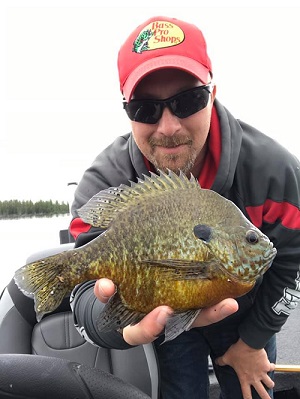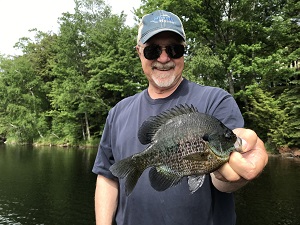
Summer brings long days and ample opportunity to fish 7 days a week, and one of the most popular species in the upper Midwest is bluegill. They are not tough to find and catch in numbers, but the big ones seem to disappear. Where do they go, and how does one catch them?
Bluegills in Lakes

Maggots on the hook when targeting
bluegills.
There are plenty of smaller bluegills in the shallows all season long, and the vast majority of pan fish anglers fish them there. The problem is quality and size is generally poor. The big fish have moved out, and here is how to find them. After the spawn in early June, the bull bluegills (fish over 8.5”) head to the first available break line looking for food and cover. Weed edges are the place to look from 6’ to 12’ on clear lakes and 3 to 6’ on the dark water lakes. The really stained tannic waters will not support weeds deeper than a few feet. Where the weeds stop is where the larger fish will be for about a month. A small fishing bobber and 1/32-ounce jig tipped with Berkley GULP Maggots will do the trick. The larger fish won’t like to come up for the jig,so place the jig about 3.5’ or more under the float. Use 4# to 6# Berkley Trilene fishing line or Fireline, a medium light rod, and a size 10 spinning reel.
Finding the bluegills is easy with a Humminbird Side Imaging s onar, just cruise the edges marking waypoints where you see groups of fish on the edges. Frequently the crappies will hang out with the larger bluegills, which usually is not something one would complain about. Once you have several schools marked, go back and methodically fish each school by spot-locking on them with Minn Kota or deploying a Talon shallow water anchor and begin looking for the nice ones.
onar, just cruise the edges marking waypoints where you see groups of fish on the edges. Frequently the crappies will hang out with the larger bluegills, which usually is not something one would complain about. Once you have several schools marked, go back and methodically fish each school by spot-locking on them with Minn Kota or deploying a Talon shallow water anchor and begin looking for the nice ones.
A fly rod and small popper can really be fun if fly fishing is your preferred presentation. I would wait for late evening to fish them with a fly or popper, as with the low light the bluegills will rise to a presentation more readily.
As Summer progresses to middle July onward, a rarely fished pattern emerges that can offer some of the best fishing of the season. Search out mid-lake humps that come up to within a few feet of the surface, and stay off the top, that will support lots of smaller fish. Fish the deep edges around the hump vertical jigging with a 1/16 th ounce jig and the above-mentioned GULP. When you contact a school of tanker bluegills, hit the spot-lock and hold on them moving along slowly the direction the school seems to be
moving. They will move along slowly, if the action slows a bit, move along the direction of the last couple captures. Weed humps are not better than rocks, the fishing depends on what the bluegills are eating, and both can provide the insects they prefer. Walleyes, small mouth , rock bass, and other fish will be mixed in with your catch. The bluegills will be there all the way until Autumn.
Bluegills in Rivers

Bluegill caught just off the edge of the
weeds in 8 feet of water.
Back bays in June to early July will fish like the lake techniques discussed above. Use your electronics and you will find the fish.
Another rarely fished pattern is wing dam fishing bull bluegills in the middle to late Summer period. Lower to moderate current is preferred. The big bluegills will be in the current breaks at the tip of the wing dam. Cast a 1/16 th ounce tipped jig into the pockets and let the current run it into the fish. Explore the entire back side of the dam and pockets along the shore where the current begins and creates some pools. The same rod and reel spooled with 10# Fireline fishing line will get you out of most of the inevitable rock
snags, but bring extra jigs, you will lose a few! Please conserve the enormously big fish by releasing them to catch another day and remember to focus on limiting your catch instead of catching your limit!
- 9226 views

